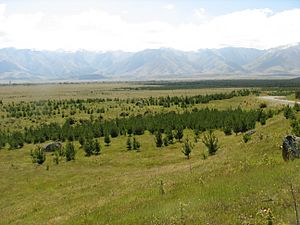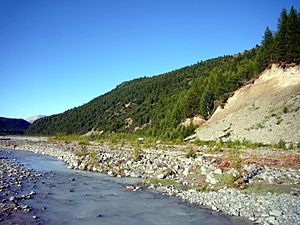Wilding conifer facts for kids
Wilding conifers, also known as wilding pines, are trees that grow where they are not wanted. They are considered an invasive species in the high country of New Zealand. Millions of dollars are spent each year to stop them from spreading.
In the South Island, these trees threaten a huge area of public land. This land is looked after by the Department of Conservation. Wilding conifers also grow on private land and along roadsides. These unwanted trees are a problem for biodiversity (the variety of life), farm land, and the natural look of the landscape. They often invade tussock grasslands. These grasslands have low-lying plants and are a natural habitat. When tall conifer trees grow there, they become a very noticeable and unwelcome sight.

Contents
Types of Wilding Conifers
There are ten main types of conifer trees that have become wildings in New Zealand:
- Bishop pine (Pinus muricata)
- Corsican pine (Pinus nigra)
- Dwarf mountain pine (Pinus mugo)
- Lodgepole pine (Pinus contorta)
- Maritime pine (Pinus pinaster)
- Ponderosa pine (Pinus ponderosa)
- Radiata pine (Pinus radiata)
- Scots pine (Pinus sylvestris)
- Douglas fir (Pseudotsuga species)
- European larch (Larix decidua)
Different types of these trees are more common in certain parts of New Zealand. Radiata pine (Pinus radiata) is used for 90% of the planted forests in New Zealand. Some of the wilding conifers come from these forests.
Stopping the Spread
If nothing is done, wilding conifers will keep spreading. This will cause problems for the economy and the environment. Many groups work to remove these trees. Volunteers, regional councils, and the Department of Conservation all help.
In 2006, a group called the South Island Wilding Conifer Management Group was formed. They received money from the Ministry of Agriculture and Forestry to help with their work.
How They Are Removed
Common ways to control wilding conifers include:
- Hand pulling: Young trees are pulled out by hand.
- Cutting: Brush cutters and chainsaws are used to cut down larger trees.
- Spraying: Special sprays are also being tested to kill the trees.
In 2004, the Department of Conservation sprayed an area called Mid Dome in the Southland region. Some of the spray drifted onto nearby towns like Athol and Kingston. This is called spray drift.
Wilding Conifers by Area
Local councils manage pests in their areas. New Zealand has sixteen different regions. Wilding conifers are mostly found in a few of these regions, mainly in the South Island. The Department of Conservation manages these trees on public land.
Canterbury Region
The Canterbury Regional Council aims to get rid of all wilding conifers that have grown by themselves in sensitive natural areas. They do this by:
- Carrying out control operations.
- Asking people to report where wilding conifers are seen.
- Encouraging the removal of trees that spread seeds.
- Suggesting changes to local rules to stop or control planting of these trees.
Hawke's Bay Region
Wilding conifers have spread into the Kaweka Forest Park in this region.
Marlborough Region
Pinus contorta (Lodgepole pine) is a problem in southern Marlborough. It is called a "Containment Control Pest." This means it is managed to stop it from spreading to new places. Other wilding trees are in Marlborough, but Lodgepole Pine is the main focus for pest control.
Otago Region
Pinus contorta is also listed as a pest plant by the Otago Regional Council.
Southland Region
A big area where wilding conifers have spread is the Mid Dome Area in the Southland region. The Mid Dome Wilding Trees Charitable Trust was set up in 2006. In 2008, the government gave $54,000 to help control wildings on about 1,000 hectares in this area.



